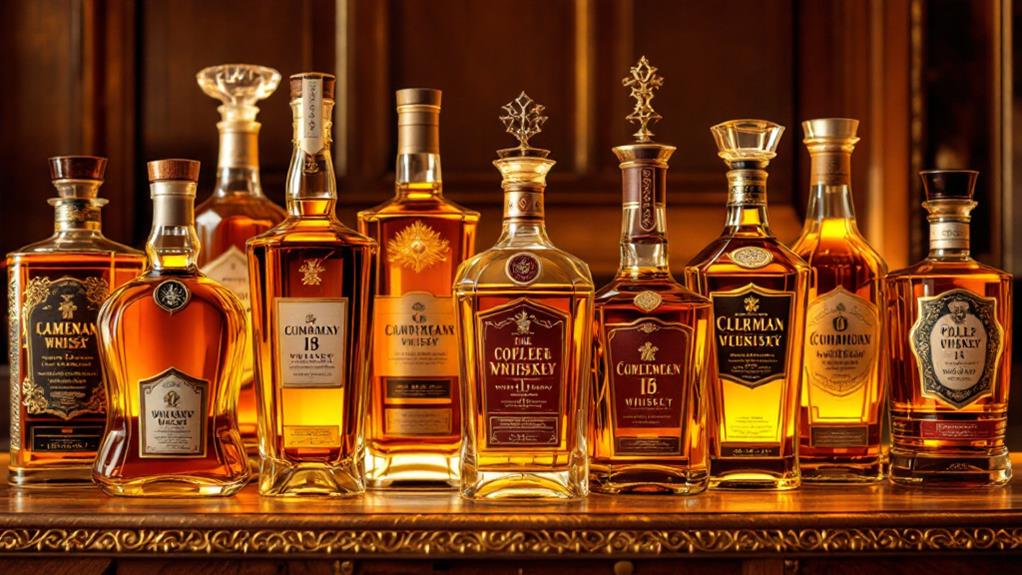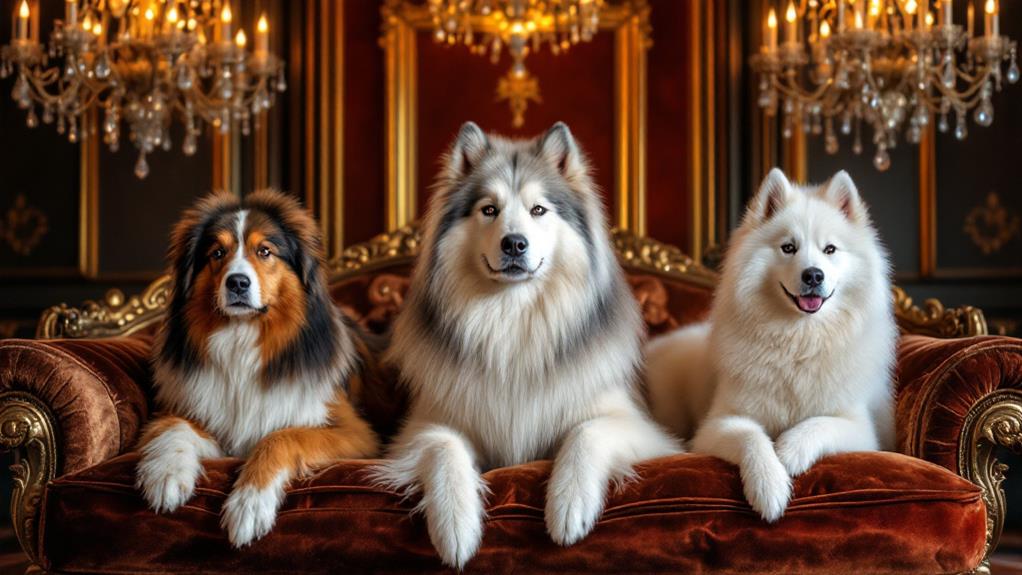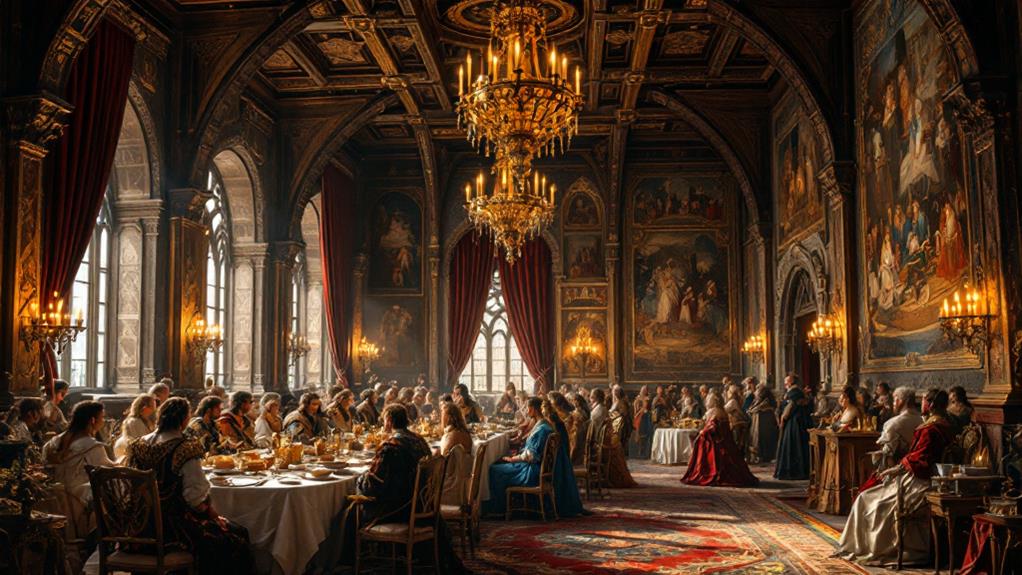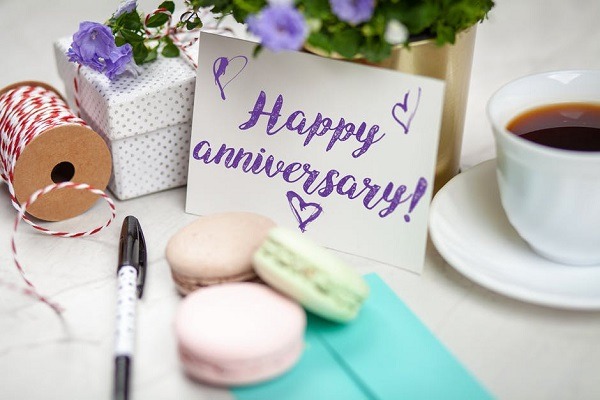What Are the British Crown Jewels? A Complete Guide
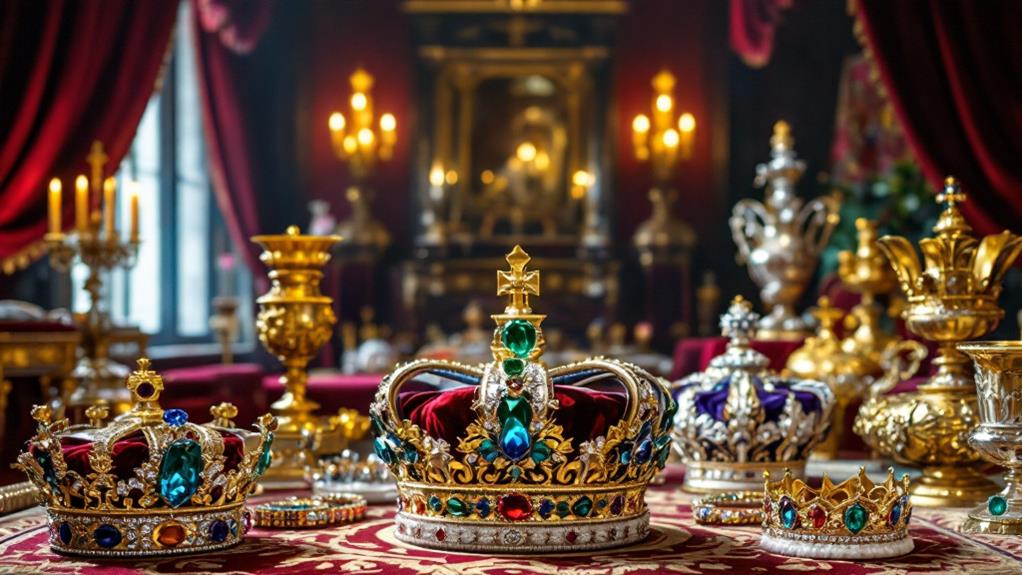
The British Crown Jewels are an exquisite collection of regalia housed in the Tower of London. They symbolize the rich heritage and continuity of the British monarchy. The collection includes around 140 objects, adorned with a staggering 23,578 gemstones. Key pieces include St Edward's Crown, used during coronations, and the Sovereign's Sceptre boasting the massive Cullinan I diamond. These jewels have a storied past, including surviving theft attempts and civil disturbances. They draw millions of visitors each year, intrigued by their beauty and history. Uncover the tales and gems behind these iconic symbols of royal authority.
Historical Significance
While exploring the rich tapestry of British history, you'll find the Crown Jewels to be a compelling symbol of the nation's heritage and monarchy. Housed in the iconic Tower of London, these jewels represent a remarkable continuity of the British monarchy, serving as the sole working set of coronation regalia in Europe. The collection's historical significance is immense, comprising approximately 140 objects and 23,578 gemstones. Each piece of royal regalia within this collection reflects the enduring power and authority of the British crown.
The Coronation Spoon, dating back to the 12th century, stands as the oldest piece in the collection, highlighting the rich historical lineage of the Crown Jewels. Most items were crafted following the Restoration of the monarchy in 1660, when Charles II ascended to the throne. This period marked a rebirth of the monarchy after the turmoil of the English Civil War, which saw earlier regalia sold or destroyed. The Royal Collection Trust now protects these valuables, preserving their historical significance for the nation. As guardians of the jewels, they guarantee these symbols of the monarchy's heritage continue to captivate the millions who visit annually.
Key Objects and Uses
Having examined the historical significance of the British Crown Jewels, let's focus on the key objects that form this illustrious collection and their uses in royal ceremonies. The Crown Jewels include the magnificent St Edward's Crown, crafted from solid gold and adorned with semi-precious stones. Weighing 2.23 kg (nearly 5 lbs), it plays a central role during the coronation ceremony, symbolizing the monarch's divine right to rule.
Then there's the Imperial State Crown, created in 1937 for King George VI. It's a breathtaking piece featuring 2,868 diamonds, including the famous Cullinan II diamond. You'll see the monarch wear this crown during state occasions, showcasing the splendor of royal authority.
The Sovereign's Sceptre with Cross stands out with its Cullinan I diamond, the largest cut diamond in the world at 530.2 carats. It's been a fixture in every coronation since 1661, underlining the power vested in the sovereign.
Additionally, the Coronation Spoon, dating back to the 12th century, is used to anoint sovereigns with holy oil, a sacred tradition in the coronation ceremony. The Sovereign's Orb, adorned with 365 diamonds and 266 cultured pearls, symbolizes the monarch's authority over the Christian world.
Evolution Over Time
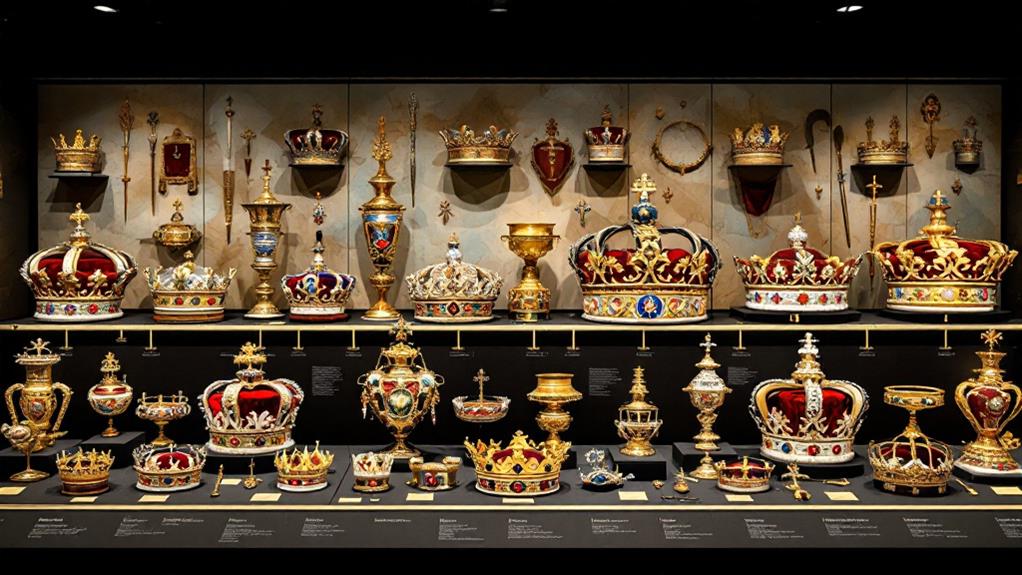
The evolution of the British Crown Jewels tells a fascinating story of resilience and renewal. During the English Civil War, many of the initial regalia were destroyed or sold. However, following the Restoration of the monarchy in 1660, a new set of Crown Jewels was commissioned for Charles II's coronation. This marked a significant rebirth for the British monarchy, with the regalia reflecting a fresh start after the tumultuous Interregnum period. The new collection drew inspiration from the legacy of Edward the Confessor, the primary to establish hereditary coronation regalia in Europe.
The Crown Jewels have endured major historical events, adding layers to their story. In 1671, for example, Colonel Thomas Blood's daring theft attempt and the regalia's subsequent recovery highlighted their symbolic importance and vulnerability. Despite such challenges, the jewels have continued to evolve.
Fast forward to recent times, with Charles III's stole added in 2023, you can see the ongoing traditions and adaptations that define the British monarchy. Each piece in the collection not only serves ceremonial purposes but also reflects the historical odyssey and the evolving identity of the monarchy through the eras.
Notable Crowns and Jewels
As you investigate the remarkable voyage of the British Crown Jewels, your attention naturally shifts to the notable crowns and jewels themselves, each piece a demonstration of the monarchy's grandeur and history. Central to this collection is the St Edward's Crown, reserved solely for the coronation. Weighing 2.23 kg, it's adorned with semi-precious stones and represents the enduring legacy of royal ceremonies. The Imperial State Crown, made for King George VI in 1937, dazzles with 2,868 diamonds, including the famous Black Prince's Ruby and Cullinan II diamond, and is worn during state occasions and post-coronation events.
The Sovereign's Sceptre with Cross is another key piece, featuring the Cullinan I diamond, the largest cut diamond globally, weighing an astonishing 530.2 carats. This sceptre, part of the British Crown Jewels since 1661, epitomizes royal authority. Queen Mary's Crown, designed for royal wives, originally showcased the Koh-i-Noor diamond, illustrating the tradition of consort crowns in coronation ceremonies. Furthermore, the Prince of Wales coronets, evolving since 1728, symbolize a rank just below the monarch, providing further layers to the rich tapestry of the British Crown Jewels.
Visiting the Jewel House
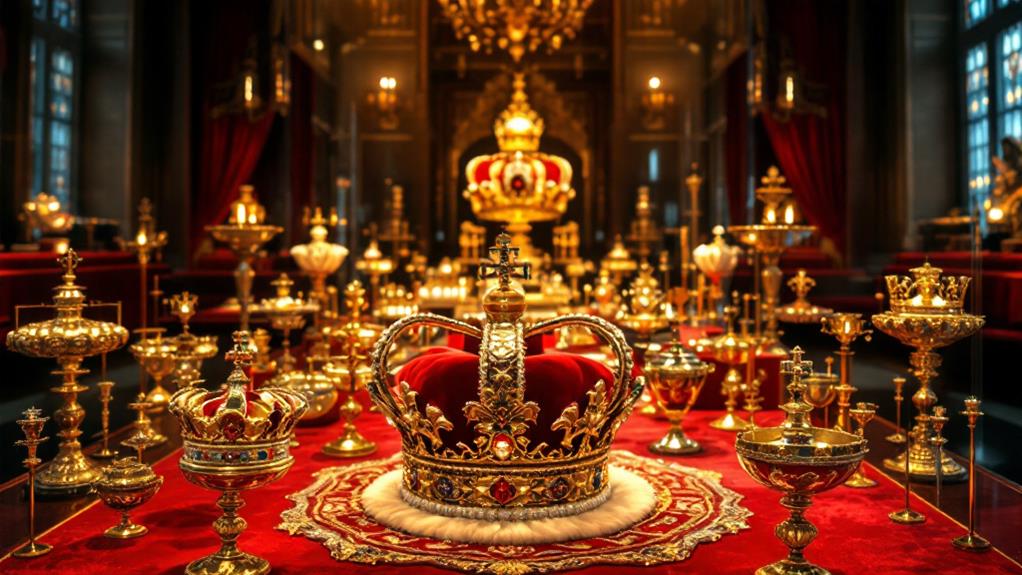
Step into the Jewel House at the Tower of London, where you'll find yourself surrounded by the dazzling history of the British Crown Jewels. This extraordinary Crown Jewels collection attracts around 2.5 million visitors each year, enthusiastic to witness the splendor of royal artifacts firsthand. As you investigate, you'll encounter approximately 140 remarkable objects, including crowns, sceptres, and orbs, all adorned with a staggering 23,578 gemstones.
The exhibition captivates with its display of historical significance and expert craftsmanship, offering a glimpse into the royal heritage of Britain. Among these valuables, the Coronation Spoon stands out as the oldest piece, dating back to the 12th century. Each item tells a story, highlighting the enduring legacy of the monarchy.
Managed by the Royal Collection Trust and Historic Royal Palaces, the Crown Jewels are revered as national valuables, carefully protected for future generations. These organizations guarantee that the jewels' historical importance is preserved and shared with the world.
For more detailed information and to improve your experience, official websites like hrp.org.uk and rct.uk offer insights into the history and significance of the Crown Jewels, helping you appreciate this extraordinary exhibition even more.
Famous Thefts and Incidents
Imagine the audacity it took for Colonel Thomas Blood to attempt stealing the British Crown Jewels. In 1671, Blood, disguised as a clergyman, attacked Talbot Edwards, the Keeper of the Jewels. He managed to seize key valuables, including the Imperial State Crown. However, just as he was preparing his escape, Blood's theft was foiled, and he was captured. Surprisingly, King Charles II pardoned him and even granted him land in Ireland, a twist that remains one of history's great mysteries.
The Crown Jewels have long been a target, not just during Blood's escapade. During the English Civil War, a significant portion of the Jewels was destroyed or sold off, causing a considerable loss of heritage as Parliament asserted control. Yet, they've also been remarkably preserved through adversity. During the Great Fire of London in 1666, the Jewels were temporarily stored in a private home, safeguarding them from potential destruction.
Today, the Crown Jewels are under tight security at the Tower of London. Numerous theft attempts have prompted improved protections, ensuring these symbols of the monarchy remain secure for future generations to admire.
Merchandise and Souvenirs
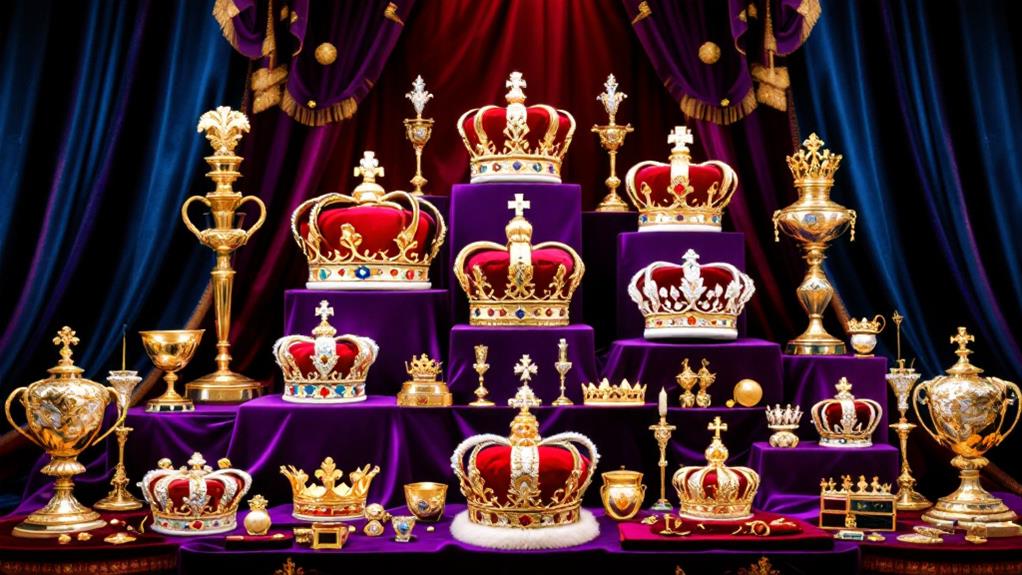
When you visit the Tower of London, a wide array of Crown Jewels merchandise awaits to commemorate your experience. You'll find a diverse selection of souvenirs celebrating royal events, with prices starting as low as £2.50. These items cater to both tourists and collectors, ensuring that everyone can take home a piece of British history. Among the offerings are raven-themed gifts, drawing inspiration from the Tower's legendary six ravens. Starting at £3.00, these products are perfect for enthusiasts of history and mythology.
For those interested in the architectural marvels of the Tower, exclusive decorations of the White Tower are available. Priced at £30.00, these items combine historical significance with decorative appeal, making them ideal collectibles. The Crown Jewels merchandise features designs that echo the rich heritage and artistry of the royal regalia, enhancing their value as keepsakes.
To investigate these offerings, visit official websites like hrp.org.uk and rct.uk, where you'll find a selection of Crown Jewels merchandise along with visitor information and historical context. These platforms provide everything you need to plan your visit and deepen your understanding of this iconic British gem.

